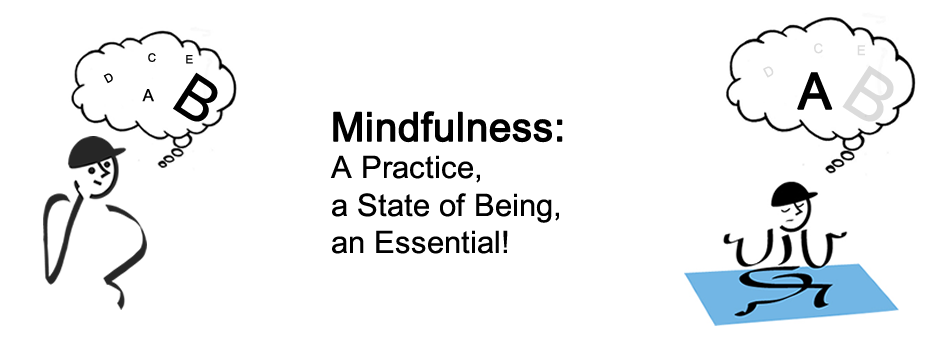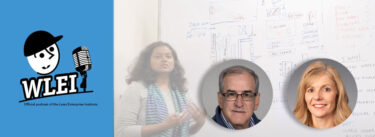Many of us are familiar with the term “mindfulness,” especially in the context of being aware of our surroundings. But there is much more to mindfulness than just that, from its many different forms to its role in a lean transformation and beyond. Amy Sandler shares more about this versatile term and how we can harness it to improve our everyday lives.
To you what is the definition of mindfulness? What does it mean to you?
I would say that mindfulness is both a practice and also a state of mind that results from that practice. One definition that I like from Dan Harris, who wrote the book 10% Happier, is this idea that you know what’s going on in your mind without getting carried away by it.
That’s the definition of it as a practice. Then there’s mindfulness as a state of being – awareness. For that aspect I like to use a definition by Jon Kabat-Zinn, who introduced Mindfulness-Based Stress Reduction (MBSR), which is a popular way to train mindfulness. What Kabat-Zinn said is that mindfulness is the awareness that arises when we pay attention, on purpose, in the present moment, non-judgmentally.
What does mindfulness look like in practice?
Let’s say you’re talking in a meeting. I’m listening to you talking, but I’m also noticing that my direct report isn’t really paying attention. Maybe Sally is on her phone. Maybe the temperature in the room is a little cold and someone is shivering and someone else is looking at their watch. I’m listening to what you’re saying because you’re the person that’s speaking, but I’m also able to have sort of a broader awareness of the overall state of everything that’s in my world view – including my own body sensations, thoughts and feelings. It’s almost like a quality of attention, and it can be both focused (me listening to you talking) and open (me observing what the other attendees are doing and noticing any reactions I might be having).
Unfortunately that doesn’t always happen. There was a study done out of Harvard by Killingsworth and Gilbert, which found that in 47 percent of our waking hours we’re thinking about something other than what we’re doing. A different study found that only 2 percent of us are actually doing something about it (i.e., enhancing our personal productivity.)
So that’s a general business context. What role does increased mindfulness play in a lean transformation?
It can offer a lot of benefits. If our mind is wandering, then how are we showing up on the job? Are we making mistakes? Are we having potentially damaging incidents on the assembly line? Are we missing things on our gemba walks? As we train and develop mindfulness, we’re increasing focus and developing more resilience. We’re able to identify problems more quickly because we have more clarity. By training our attention on what’s happening right in front of us, we can access more information – like a picture with more pixels, a higher resolution camera that can help us drill into where the problem might be.
Then we’re also able to access the bigger picture that comes with awareness where we can ask: “Is this really contributing? Is this valuable? Is it waste that I might have missed before?” So we’re able to get really granular with the focus aspect of mindfulness, and also see the big picture with more open awareness.
Mindfulness can also play a role in the purpose aspect of lean. The first step in the lean transformation model is identifying your purpose. The awareness that we train through mindfulness is very similar to self-awareness, which is the foundational competency of emotional intelligence. So, as you train mindfulness, you can also develop your emotional intelligence. We can gain a better lens into some of those bigger questions: “What’s my purpose? What’s our organization’s purpose? Are we aligned?”
What characterizes the organization that has embraced mindfulness? What advantages does it hold over the one that is not mindful?
I would look at this in three buckets. One would be around effectiveness, so things like, “We’re more productive. We’re more engaged.” You’re able to retain employees. You’re able to be more innovative.
Then there’s the leadership bucket, and this can be developed as well. As we train on mindfulness and self-awareness, we also develop more empathy, more of an ability to understand and put ourselves in the other person’s shoes. We can resolve conflict better because we’re able to avoid making a knee-jerk response and instead create some space between when we’re triggered (say, by an email putting a new project on our plate) and our response. We’re able to make more skillful decisions and can work with our teams and direct reports in more collaborative ways.
The final bucket would be well-being. There’s some interesting research on how mindfulness at work can help reduce absenteeism and decrease organizational healthcare costs.
Once I had a CEO say to me at the end of a workshop: “I have been sending emails to my people at 3 a.m. I realized that even though I write in the email, ‘You don’t have to respond,’ just the very act of the CEO sending an email at 3 a.m. sends everyone into a panic.” Practicing mindfulness helps you start to realize what you’re doing, what message you’re sending, and you can gain more visibility into, “What’s my impact on those around me?”
What are some easy ways we can practice being more mindful at work?
Waking up:
Spend two minutes in bed just noticing your breath. As thoughts about the day pop into your mind, let them go and return to your breath.
If you find yourself wanting to pick up your phone to check email, just notice that and again gently return your attention to your breath.
Arriving at the office:
Take three breaths in your car or at your desk before you start your work day. Set your intention for the day – maybe it’s to be more patient, maybe it’s to be more focused, whatever resonates with you. Setting an intention can be a powerful start to your day.
Anytime:
- Focus attention on the breath.
- Pause to notice sensations, emotions or thoughts.
- For a few minutes, shift from “doing” to “being.”
So keep on breathing – you’re doing it anyhow!
To learn more ways to increase mindfulness in our daily lives, stop by Amy Sandler’s Learning Session with Mark Donovan at the 2017 Lean Transformation Summit: Mindfulness: A Research-Based Way to Supercharge Your Lean Thinking, Practice, and Results. More information is available on the Summit webpage.





